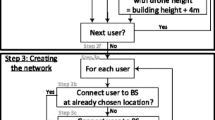Abstract
In the case of crisis and disaster situations, Public Safety Organization (PSO) experience situations where most of the telecommunication infrastructure becomes unavailable or not reliable. Thus, an effective disaster assessment of the situation becomes a challenging task for the PSO. UAV is considered as the most suitable solution to address these scenarios where a maximal radio coverage of the target area is crucial. In this work, a square area is considered which mathematical approximation to ensure a maximal coverage based on “covering a square with equal circles” is investigated. The proposed approach outperforms the existing ones as it reduces effectively the total difference delay time to cover the target area. Furthermore, it allows time-saving to achieve more stops at the target area compared to existing schemes leading to better PSO activity performance.







Similar content being viewed by others
Change history
03 September 2020
The names of the second and third authors in the initial online publication were not correctly typeset. The original article has been corrected.
References
Baldini, G., Karanasios, S., Allen, D. K., & Vergari, F. (2014). Survey of wireless communication technologies for public safety. IEEE Communications Surveys & Tutorials, 16, 619–641.
Zeng, Y., Zhang, R., & Lim, T. J. (2016). Wireless communications with unmanned aerial vehicles: Opportunities and challenges. IEEE Communications Magazine, 54, 36–42.
Kumbhar, A., Koohifar, F., & Güvenç, Ï., & Mueller, B., (2017). A survey on legacy and emerging technologies for public safety communications. IEEE Communications Surveys Tutorials, 19, 97–124.
Merwaday, A., & Guvenc, I. (2015). UAV assisted heterogeneous networks for public safety communications. In 2015 IEEE wireless communications and networking conference workshops (WCNCW) (pp. 329–334).
Erdelj, M., Natalizio, E., Chowdhury, K. R., & Akyildiz, I. F. (2017). Help from the sky: Leveraging UAVs for disaster management. IEEE Pervasive Computing, 16, 24–32.
Fink, S. (2013). Crisis communications: The definitive guide to managing the message. New York: McGraw-Hill Education.
Mozaffari, M., Saad, W., Bennis, M., Nam, Y., & Debbah, M. (2019). A tutorial on UAVs for wireless networks: Applications, challenges, and open problems. IEEE Communications Surveys Tutorials, 21(3), 2334–2360.
Al-Hourani, A., Kandeepan, S., & Jamalipour, A. (2014). Modeling air-to-ground path loss for low altitude platforms in urban environments. In 2014 IEEE global communications conference (pp. 2898–2904).
Chen, Y., Lin, X., Khan, T., & Mozaffari, M. (2020). Efficient drone mobility support using reinforcement learning. In 2020 IEEE wireless communications and networking conference (WCNC) (pp. 1–6).
French, A., Mozaffari, M., Eldosouky, A., & Saad, W. (2019). Environment-aware deployment of wireless drones base stations with google earth simulator. In 2019 IEEE international conference on pervasive computing and communications workshops (PerCom Workshops) (pp. 868–873).
Fotouhi, A., Ding, M., & Hassan, M. (2016). Dynamic base station repositioning to improve performance of drone small cells. In 2016 IEEE globecom workshops.
Naqvi, S. A. R., Hassan, S. A., Pervaiz, H., & Ni, Q. (2018). Drone-aided communication as a key enabler for 5G and resilient public safety networks. IEEE Communications Magazine, 56, 36–42.
Hayajneh, A. M., Zaidi, S. A. R., McLernon, D. C., & Ghogho, M. (2016). Drone empowered small cellular disaster recovery networks for resilient smart cities. In 2016 IEEE international conference on sensing, communication and networking (SECON workshops).
Mozaffari, M., Saad, W., Bennis, M., & Debbah, M. (2015). Drone small cells in the clouds: Design, deployment and performance analysis. In 2015 IEEE global communications conference (GLOBECOM) (pp. 1–6).
Mozaffari, M., Saad, W., Bennis, M., & Debbah, M. (2015). Unmanned aerial vehicle with underlaid device-to-device communications: Performance and tradeoffs. IEEE Transactions on Wireless Communications, 15, 09.
Nurmela, Kari J., & Osterga, Patric R. J. (2016). Covering a square with up to 30 equal circles. In Teknillisen korkeakoulun tietojenka sittelyteorian laboratorion tutkimusraportti 62.
Omar, A. A., & Abo-Hammour, Z. (2014). Numerical solution of systems of second-order boundary value problems using continuous genetic algorithm. Amsterdam: Elsevier.
Omar, A. A. (2018). Numerical solutions of systems of first-order, two-point bvps based on the reproducing kernel algorithm. Calcolo.
Omar, A. A. (2019). Application of residual power series method for the solution of time-fractional schrödinger equations in one-dimensional space. Fundamenta Informaticae.
Omar, A. A. (2019). Numerical algorithm for the solutions of fractional order systems of dirichlet function types with comparative analysis. Fundamenta Informaticae.
Al-Hourani, A., Kandeepan, S., & Lardner, S. (2014). Optimal LAP altitude for maximum coverage. IEEE Wireless Communications Letters, 3(6), 569–572.
Author information
Authors and Affiliations
Corresponding author
Additional information
Publisher's Note
Springer Nature remains neutral with regard to jurisdictional claims in published maps and institutional affiliations.
The original version of this article has been revised: The names of the second and third authors have been corrected.
Rights and permissions
About this article
Cite this article
Mehallegue, N., Djellab, M. & Loukhaoukha, K. Efficient Use of UAVs for Public Safety in Disaster and Crisis Management. Wireless Pers Commun 116, 369–380 (2021). https://doi.org/10.1007/s11277-020-07719-y
Published:
Issue Date:
DOI: https://doi.org/10.1007/s11277-020-07719-y



